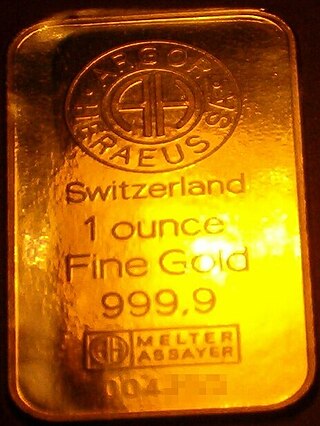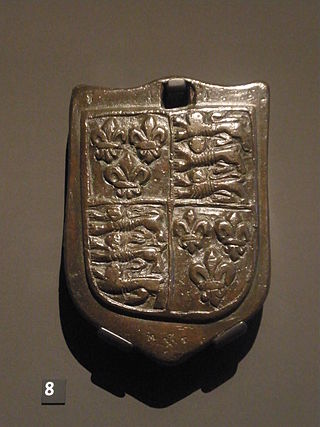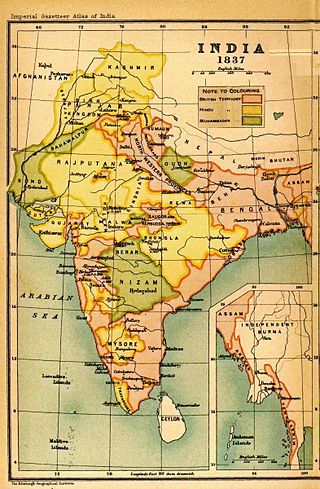
The pound or pound-mass is a unit of mass used in both the British imperial and United States customary systems of measurement. Various definitions have been used; the most common today is the international avoirdupois pound, which is legally defined as exactly 0.45359237 kilograms, and which is divided into 16 avoirdupois ounces. The international standard symbol for the avoirdupois pound is lb; an alternative symbol is lbm, #, and ℔ or ″̶.

Troy weight is a system of units of mass that originated in 15th-century England, and is primarily used in the precious metals industry. The troy weight units are the grain, the pennyweight, the troy ounce, and the troy pound. The troy grain is equal to the grain unit of the avoirdupois system, but the troy ounce is heavier than the avoirdupois ounce, and the troy pound is lighter than the avoirdupois pound. One troy ounce equals exactly 31.1034768 grams.

Avoirdupois is a measurement system of weights that uses pounds and ounces as units. It was first commonly used in the 13th century AD and was updated in 1959.
The batman was a unit of mass used in the Ottoman Empire and among Turkic peoples of the Russian Empire. It has also been recorded as a unit of area in Uyghur-speaking regions of Central Asia. The name is Turkic, but was also sometimes used for the equivalent unit in Persia. The equivalent unit in British India was anglicized as the maund. The value of the batman varied considerably from place to place.

The stone or stone weight is an English and imperial unit of mass equal to 14 pounds (6.35 kg). The stone continues in customary use in the United Kingdom for body weight.

The tola also transliterated as tolah or tole, is a traditional Ancient Indian and South Asian unit of mass, now standardised as 180 grains or exactly ⅜ troy ounce. It was the base unit of mass in the British Indian system of weights and measures introduced in 1833, although it had been in use for much longer. It was also used in Aden and Zanzibar: in the latter, one tola was equivalent to 175.90 troy grains.

James Prinsep FRS was an English scholar, orientalist and antiquary. He was the founding editor of the Journal of the Asiatic Society of Bengal and is best remembered for deciphering the Kharosthi and Brahmi scripts of ancient India. He studied, documented and illustrated many aspects of numismatics, metallurgy, meteorology apart from pursuing his career in India as an assay master at the mint in Benares.
A guz or the Mughal yard is a unit of length used in parts of Asia. Historically, it was a regionally variable measurement similar to the English yard both in size and in that it was often used for measuring textiles. Values of the guz ranged from 24 to 41 inches over time. Today, it is generally used in the Indian subcontinent as the word for a yard. A present day sari is still measured as 7 guz while a traditional one can be as long as 9 guz.
The pao is a unit of dry measure (mass) which is used in South Asia. The name may come from the Punjabi ਪਾਓ páo, which was a traditional charge of one quarter of a seer per every maund of grain that was weighed, converted into a tax by Sawan Mal. Turner also cites a Sindhi word pāu (پاءُ) meaning a quarter of a seer.

A Seer is a traditional unit of mass and volume used in large parts of Asia prior to the middle of the 20th century. It remains in use only in a few countries such as Afghanistan, Iran, and parts of India although in Iran it indicates a smaller unit of weight than the one used in India.

The Ain-i-Akbari or the "Administration of Akbar", is a 16th-century detailed document recording the administration of the Mughal Empire under Emperor Akbar, written by his court historian, Abu'l Fazl in the Persian language. It forms Volume III and the final part of the much larger document, the Akbarnama, also by Abu'l-Fazl, and is itself in three volumes.
The kos, also spelled coss, koss, kosh, krosh, and krosha, is a unit of measurement which is derived from a Sanskrit term, क्रोश krośa, which means a 'call', as the unit was supposed to represent the distance at which another human could be heard. It is an ancient Indian subcontinental standard unit of distance, in use since at least 4 BCE. According to the Arthashastra, a krośa or kos is about 3,000 metres (9,800 ft).

The Doji bara famine of 1791–1792 in the Indian subcontinent was brought on by a major El Niño event lasting from 1789–1795 and producing prolonged droughts. Recorded by William Roxburgh, a surgeon with the British East India Company, in a series of pioneering meteorological observations, the El Niño event caused the failure of the South Asian monsoon for four consecutive years starting in 1789.
Before the introduction of the Metric system, one may divide the history of Indian systems of measurement into three main periods: the pre-Akbar's period, the period of the Akbar system, and the British colonial period.

The candy or candee, also known as the maunee, was a traditional South Asian unit of mass, equal to 20 maunds and roughly equivalent to 500 pounds avoirdupois (227 kilograms). It was most used in southern India, to the south of Akbar's empire, but has been recorded elsewhere in South Asia. In Marathi, the same word was also used for a unit of area of 120 bighas, and it is also recorded as a unit of dry volume.
Patrick Kelly (1756–1842) was a British metrologist, best known for his comparative studies of weights and measures collected in his works Universal Cambist (1811) and Oriental Metrology (1832). Kelly was Master of the Finsbury Square Academy, London. He was also instrumental in the establishment of the Imperial system of measurement through the Weights and Measures Act 1824.

The Great Recoinage of 1816 was an attempt by the government of the United Kingdom of Great Britain and Ireland to re-stabilise its currency, the pound sterling, after the economic difficulties brought by the French Revolutionary Wars and the Napoleonic Wars.
A variety of units of measurement have been used in Afghanistan to measure length, mass and capacity. Those units were similar to Iranian, Arabian and Indian units. In 1924, Afghanistan adopted the metric system.
A number of different units of measurement were used in Sri Lanka to measure quantities like length, mass and capacity from very ancient times. Under the British Empire, imperial units became the official units of measurement and remained so until Sri Lanka adopted the metric system in the 1970s.














